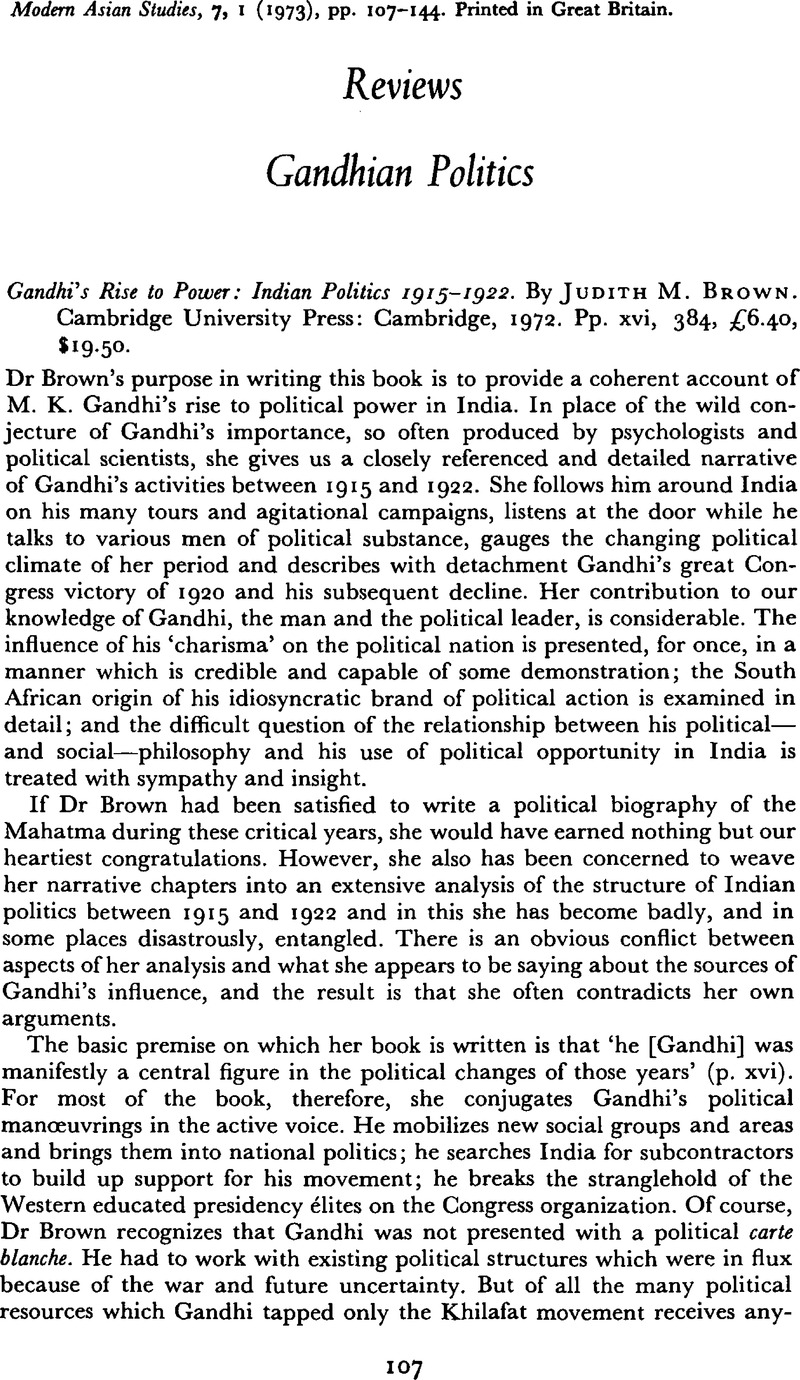Article contents
Gandhian Politics - Gandhi's Rise to Power: Indian Politics 1915–1922. By Judith M. Brown. Cambridge University Press: Cambridge, 1972. Pp. xvi, 384, £6.40, $19.50.
Published online by Cambridge University Press: 28 November 2008
Abstract

- Type
- Reviews
- Information
- Copyright
- Copyright © Cambridge University Press 1973
References
1 S. Srinivasa Iyengar was related by marriage to the Vembakkam family which produced innumerable High Court Judges, legal administrators and departmental under-secretaries in the period to 1920. S. Srinivasa Iyengar himself had been Attorney-General before resigning office in February 1920 to return to agitational politics. His proximity to important outside interests can be seen in the fact that he had been requested, in 1912, by the Maharaja of Vizianagram to become a trustee of the huge Vizianagram estate.Google Scholar
2 If we take the case of that arch-Western educated group, the Tamil Brahmin, we find that Tamil Brahmins in general owned little land and were sparsely distributed through the Tamil districts. Only in Tanjore district were Brahmins considerable landowners but even here the largest landed magnates were not Brahmins and most of the land was not in Brahmin hands.Google Scholar
3 ‘Congress was the apex of institutional politics’, p. 23.Google Scholar
4 For a discussion of mass politics in the 1880s in the Allahabad locality, see Bayly, C. A., ‘The Development of Political Organization in the Allahabad Locality. 1880–1925’. D.Phil. thesis. Oxford University. 1970.Google Scholar For a similar discussion with reference to Madras, see Washbrook, D. A., ‘Political Change in the Madras Presidency. 1880–1921’. Fellowship dissertation. Trinity College, Cambridge. 1971.Google Scholar
5 Government Order 1011 (Local and Municipal Department, Municipal Branch) dated 17 July 1901. Tamil Nadu Archives.Google Scholar
6 We cannot investigate here the non-Brahmin movement. But, briefly, the involvement of certain of the most trusted counsellors of the British in the Home Rule League agitation allowed rival politicians to offer themselves to the British as replacements. The rivals, who were non-Brahmins, made much of the fact that many Brahmins were supporters of the League and sought to convert the simple issue of a scramble for high office and influence under the British between a handful of men into a communal crusade.Google Scholar
7 In 1917, Mothey Gangarazan attended a session of the Northern Circars Non-Brahmin Conference, in company with his then lawyer K. V. Reddi Naidu. A few weeks later he presided at a district Congress conference.Google Scholar
8 Baker, C. J., ‘Political Change in South India 1919–1937.’ Fellowship dissertation. Queens' College, Cambridge. 1972. Ch. 3.Google Scholar
9 Gordon, R. A., ‘Aspects in the History of the Indian National Congress, with special reference to the Swarajya Party, 1919–1927’. D.Phil. thesis. Oxford University. 1970.Google Scholar
- 2
- Cited by




